heating TOYOTA HIGHLANDER 2013 XU50 / 3.G Owners Manual
[x] Cancel search | Manufacturer: TOYOTA, Model Year: 2013, Model line: HIGHLANDER, Model: TOYOTA HIGHLANDER 2013 XU50 / 3.GPages: 684, PDF Size: 15.42 MB
Page 167 of 684
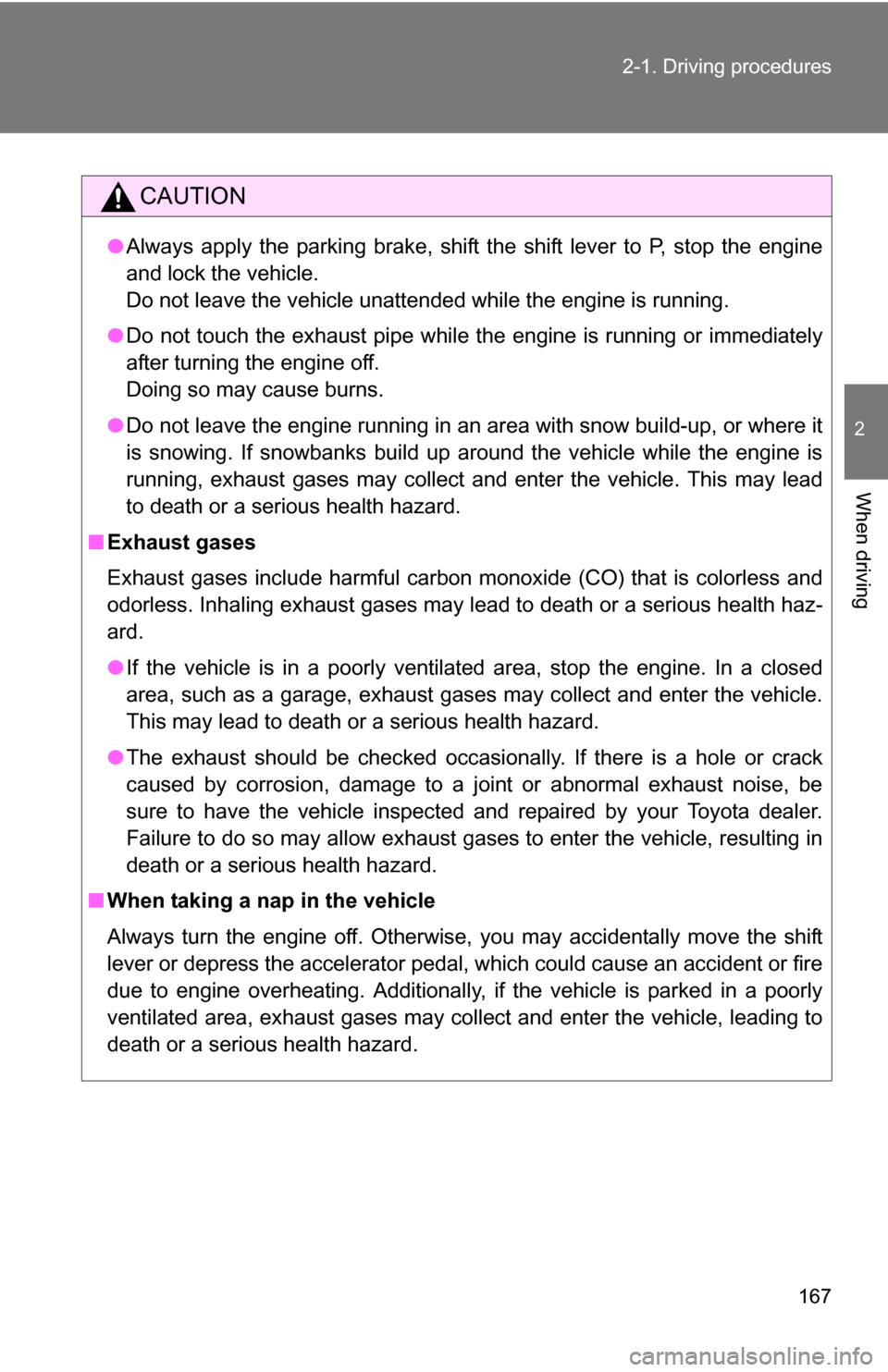
167
2-1. Driving procedures
2
When driving
CAUTION
●
Always apply the parking brake, shift the shift lever to P, stop the engine
and lock the vehicle.
Do not leave the vehicle unattended while the engine is running.
● Do not touch the exhaust pipe while the engine is running or immediately
after turning the engine off.
Doing so may cause burns.
● Do not leave the engine running in an area with snow build-up, or where it
is snowing. If snowbanks build up around the vehicle while the engine is
running, exhaust gases may collect and enter the vehicle. This may lead
to death or a serious health hazard.
■ Exhaust gases
Exhaust gases include harmful carbon monoxide (CO) that is colorless and
odorless. Inhaling exhaust gases may lead to death or a serious health haz-
ard.
●If the vehicle is in a poorly ventilated area, stop the engine. In a closed
area, such as a garage, exhaust gases may collect and enter the vehicle.
This may lead to death or a serious health hazard.
● The exhaust should be checked occasionally. If there is a hole or crack
caused by corrosion, damage to a joint or abnormal exhaust noise, be
sure to have the vehicle inspected and repaired by your Toyota dealer.
Failure to do so may allow exhaust gases to enter the vehicle, resulting in
death or a serious health hazard.
■ When taking a nap in the vehicle
Always turn the engine off. Otherwise, you may accidentally move the shift
lever or depress the accelerator pedal, which could cause an accident or fire
due to engine overheating. Additionally, if the vehicle is parked in a poorly
ventilated area, exhaust gases may collect and enter the vehicle, leadin\
g to
death or a serious health hazard.
Page 184 of 684
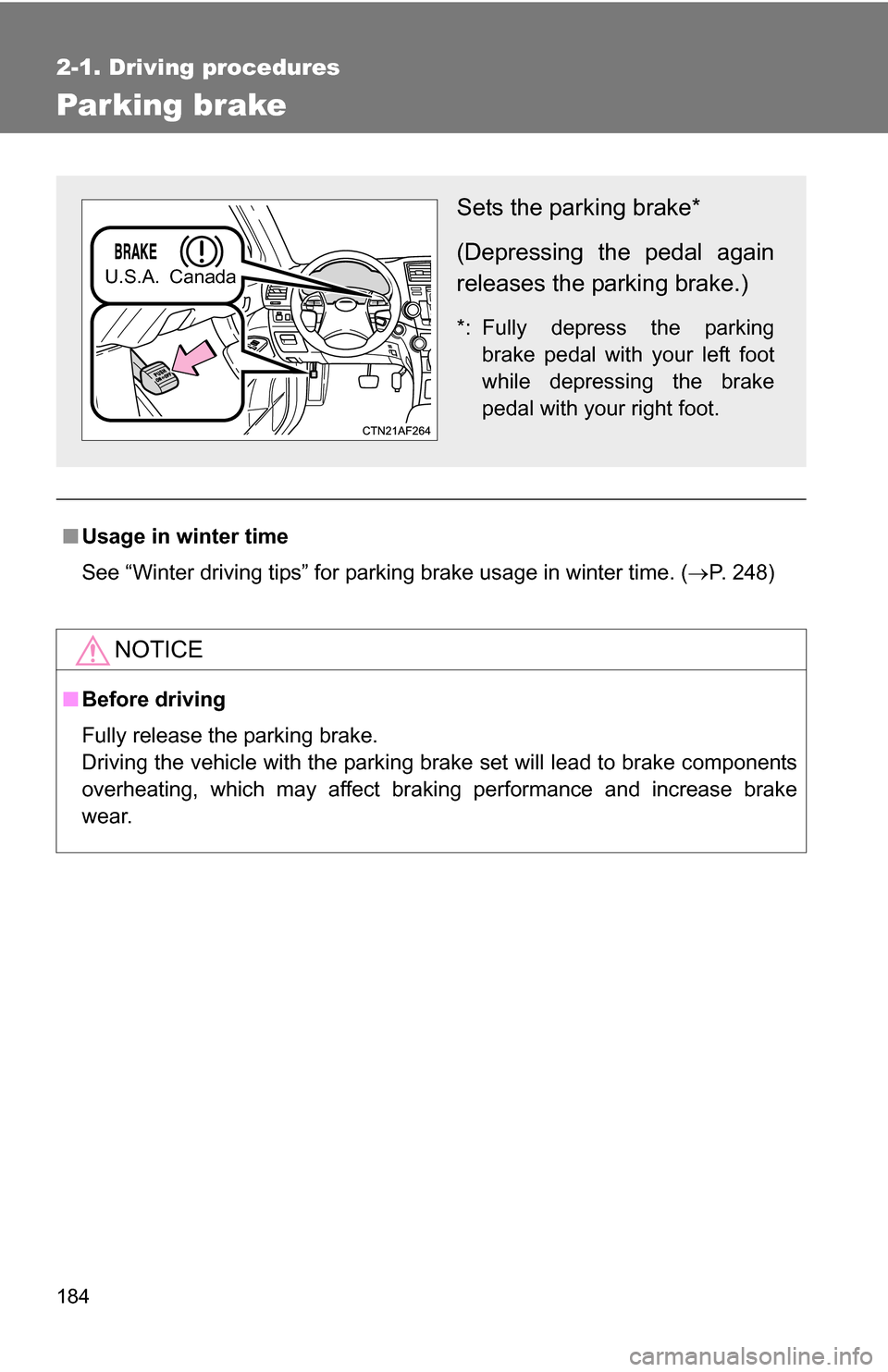
184
2-1. Driving procedures
Parking brake
■Usage in winter time
See “Winter driving tips” for parking brake usage in winter time. ( P. 248)
NOTICE
■Before driving
Fully release the parking brake.
Driving the vehicle with the parking brake set will lead to brake components
overheating, which may affect braking performance and increase brake
wear.
Sets the parking brake*
(Depressing the pedal again
releases the parking brake.)
*: Fully depress the parking
brake pedal with your left foot
while depressing the brake
pedal with your right foot.
U.S.A. Canada
Page 187 of 684
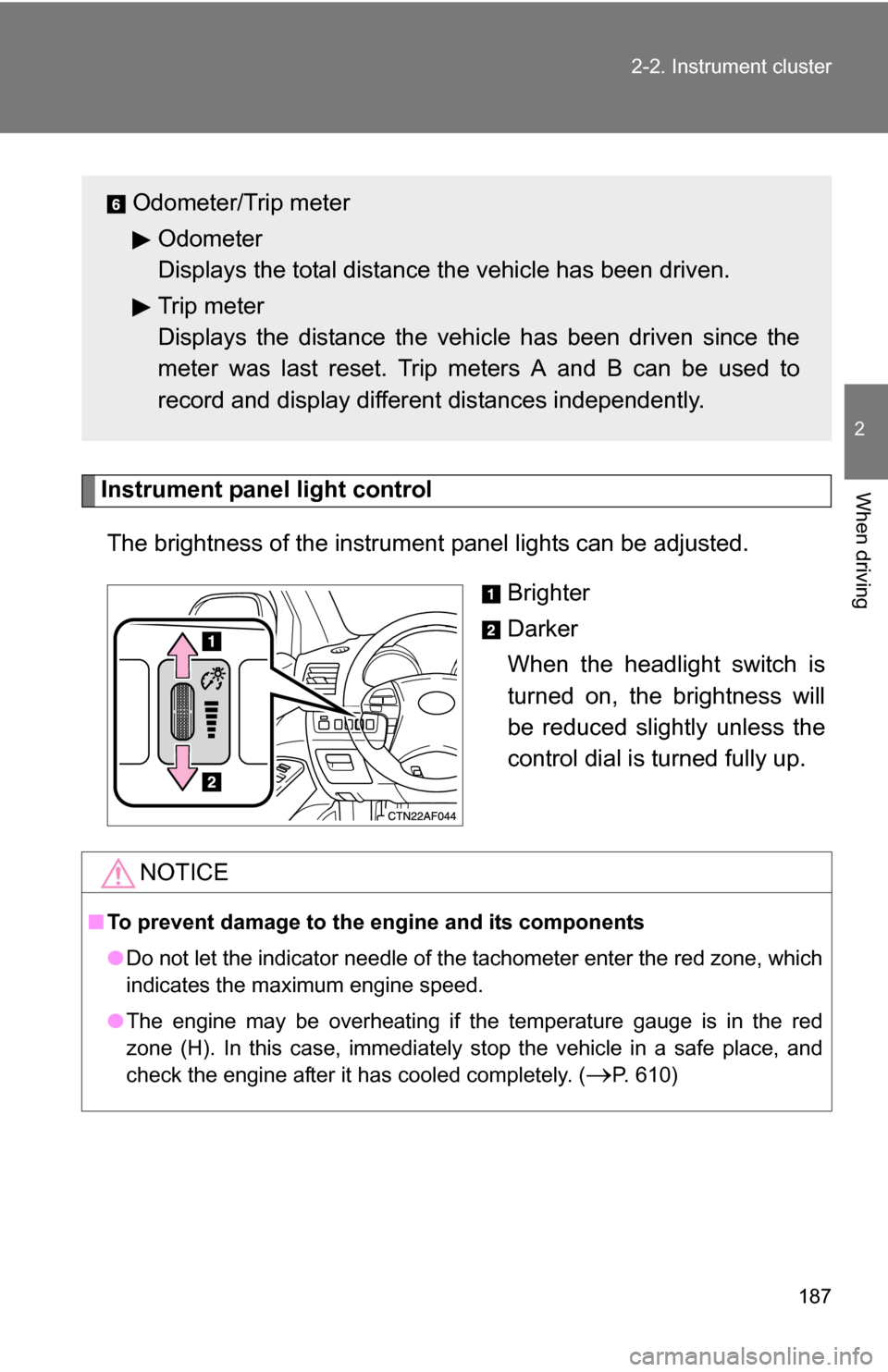
187
2-2. Instrument cluster
2
When drivingInstrument panel light control
The brightness of the instrument panel lights can be adjusted.
Brighter
Darker
When the headlight switch is
turned on, the brightness will
be reduced slightly unless the
control dial is turned fully up.
Odometer/Trip meterOdometer
Displays the total distance the vehicle has been driven.
Trip meter
Displays the distance the vehi cle has been driven since the
meter was last reset. Trip meters A and B can be used to
record and display different distances independently.
NOTICE
■ To prevent damage to the engine and its components
●Do not let the indicator needle of the tachometer enter the red zone, which
indicates the maximum engine speed.
● The engine may be overheating if the temperature gauge is in the red
zone (H). In this case, immediately stop the vehicle in a safe place, and
check the engine after it has cooled completely. (
P. 610)
Page 230 of 684

230 2-4. Using other driving systems
■Sounds and vibrations caused by the ABS, TRAC, VSC and brake
assist
●A sound may be heard from the engine compartment when the engine is
started or just after the vehicle begins to move. This sound does not indi-
cate that a malfunction has occurred in any of these systems.
● Any of the following conditions may occur when the above systems are
operating. None of these indicates that a malfunction has occurred.
• Vibrations may be felt through the vehicle body and steering.
• A motor sound may be heard after the vehicle comes to a stop.
• The brake pedal may pulsate slightly when the ABS is activated.
• The brake pedal may move down slightly after the ABS is activated.
■ EPS operation sound
When the steering is wheel operated, a motor sound (whirring sound) may
be heard. This does not indicate a malfunction.
■ Reduced effectiveness of EPS system
The effectiveness of the EPS system is reduced to prevent the system from
overheating when there is frequent steering input over an extended period of
time. The steering wheel may feel heavy as a result. Should this occur,
refrain from excessive steering input or stop the vehicle and turn the engine
off. The EPS system should return to normal within 10 minutes.
■ If the slip indicator comes on...
It may indicate a malfunction in the VSC and TRAC. Contact your Toyota
dealer.
CAUTION
■The ABS does not operate effectively when
●The limits of tire gripping performance have been exceeded (such as
excessively worn tires on a snow covered road).
● The vehicle hydroplanes while driving at high speed on wet or slick road.
Page 262 of 684
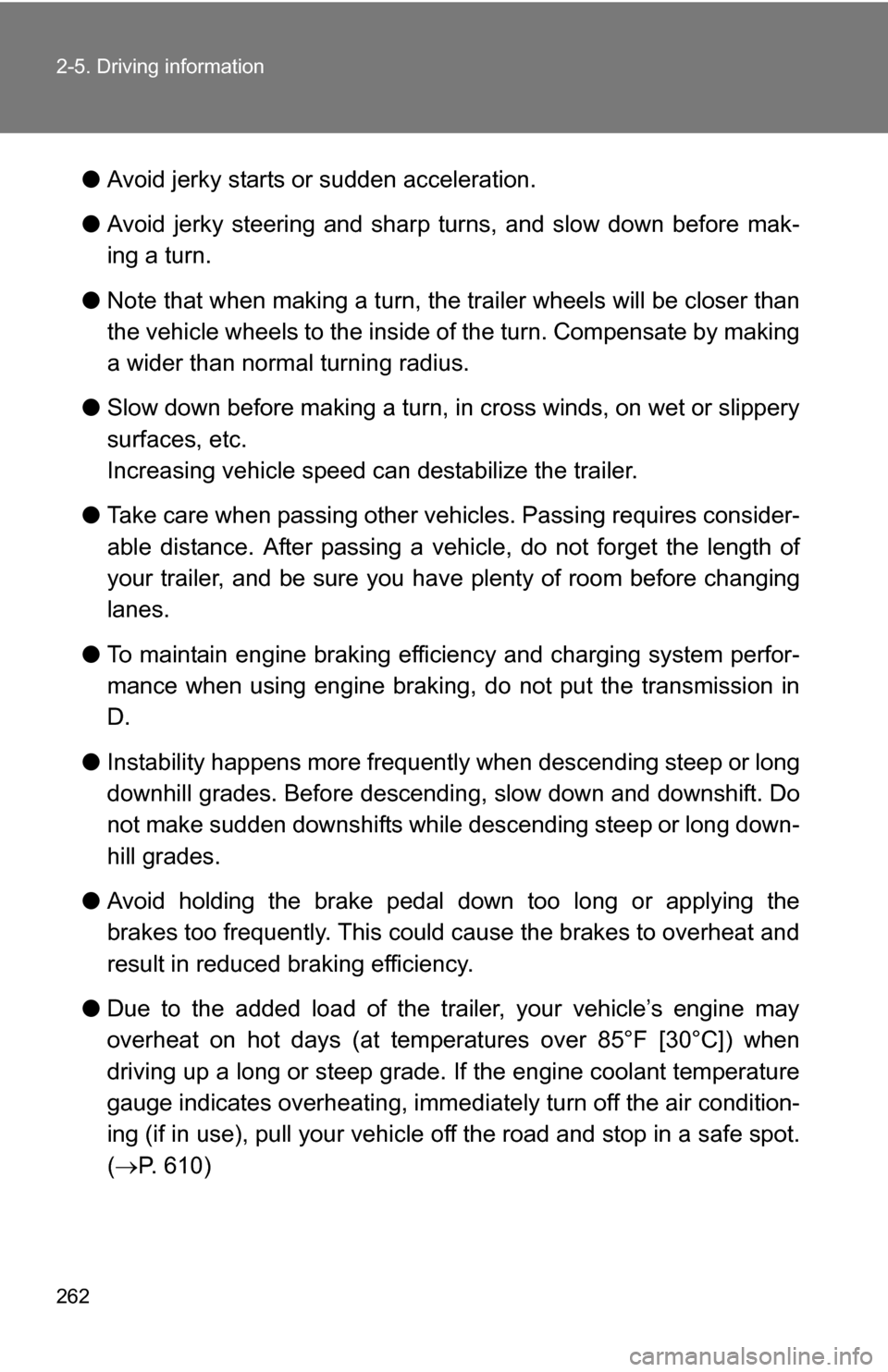
262 2-5. Driving information
●Avoid jerky starts or sudden acceleration.
● Avoid jerky steering and sharp turns, and slow down before mak-
ing a turn.
● Note that when making a turn, th e trailer wheels will be closer than
the vehicle wheels to the inside of the turn. Compensate by making
a wider than normal turning radius.
● Slow down before making a turn, in cross winds, on wet or slippery
surfaces, etc.
Increasing vehicle speed c an destabilize the trailer.
● Take care when passing other v ehicles. Passing requires consider-
able distance. After passing a vehi cle, do not forget the length of
your trailer, and be sure you hav e plenty of room before changing
lanes.
● To maintain engine braking efficiency and charging system perfor-
mance when using engine braking, do not put the transmission in
D.
● Instability happens more frequently when descending steep or long
downhill grades. Before descending, slow down and downshift. Do
not make sudden downshifts while descending steep or long down-
hill grades.
● Avoid holding the brake pedal down too long or applying the
brakes too frequently. This could cause the brakes to overheat and
result in reduced braking efficiency.
● Due to the added load of the trailer, your vehicle’s engine may
overheat on hot days (at temper atures over 85°F [30°C]) when
driving up a long or steep grade. If the engine coolant temperature
gauge indicates overheating, immediately turn off the air condition-
ing (if in use), pull your vehicle off the road and stop in a safe spot.
( P. 610)
Page 461 of 684
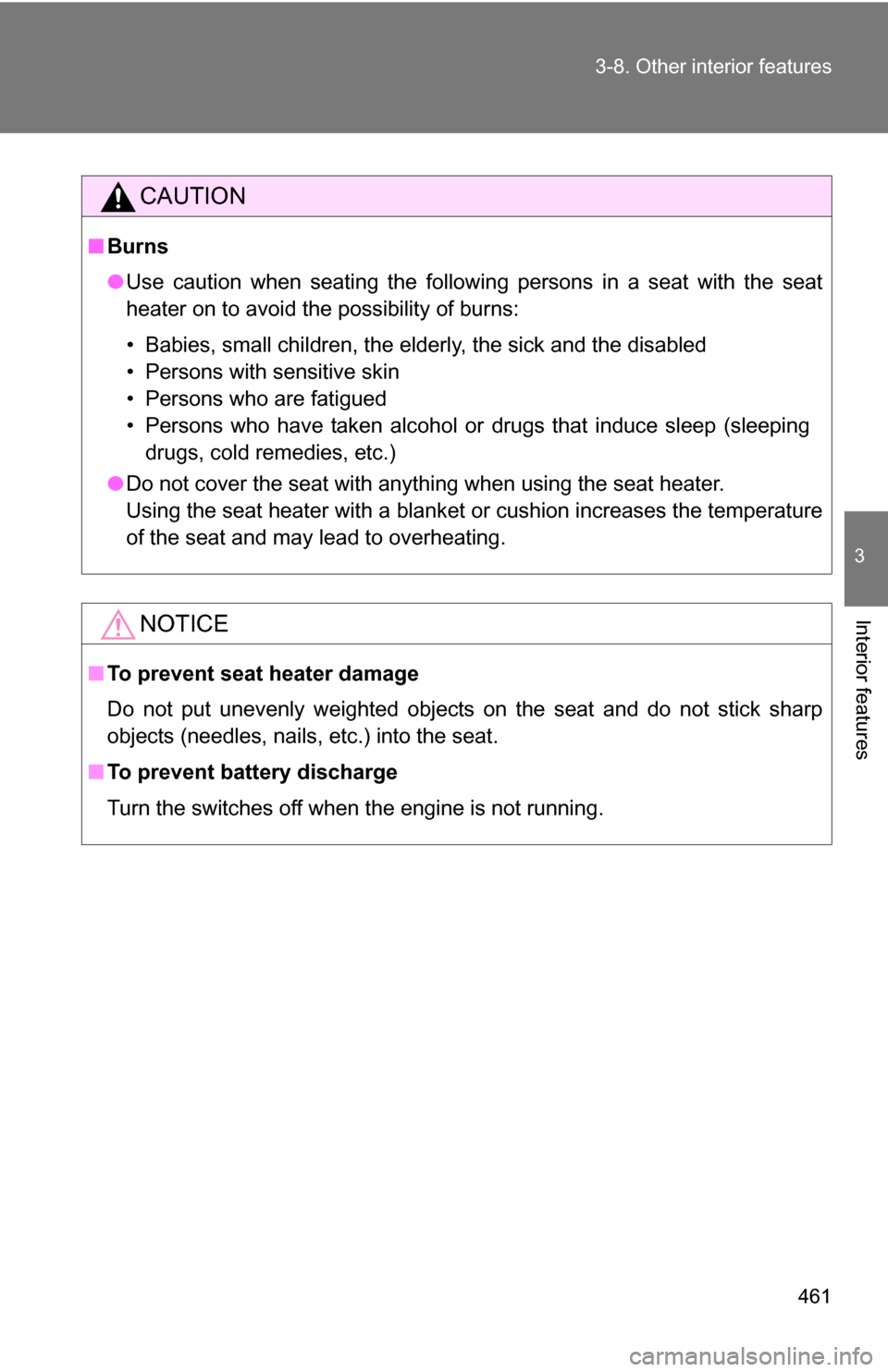
461
3-8. Other interior features
3
Interior features
CAUTION
■
Burns
●Use caution when seating the following persons in a seat with the seat
heater on to avoid the possibility of burns:
• Babies, small children, the elderly, the sick and the disabled
• Persons with sensitive skin
• Persons who are fatigued
• Persons who have taken alcohol or drugs that induce sleep (sleeping
drugs, cold remedies, etc.)
● Do not cover the seat with anything when using the seat heater.
Using the seat heater with a blanket or cushion increases the temperature
of the seat and may lead to overheating.
NOTICE
■To prevent seat heater damage
Do not put unevenly weighted objects on the seat and do not stick sharp
objects (needles, nails, etc.) into the seat.
■ To prevent battery discharge
Turn the switches off when the engine is not running.
Page 611 of 684
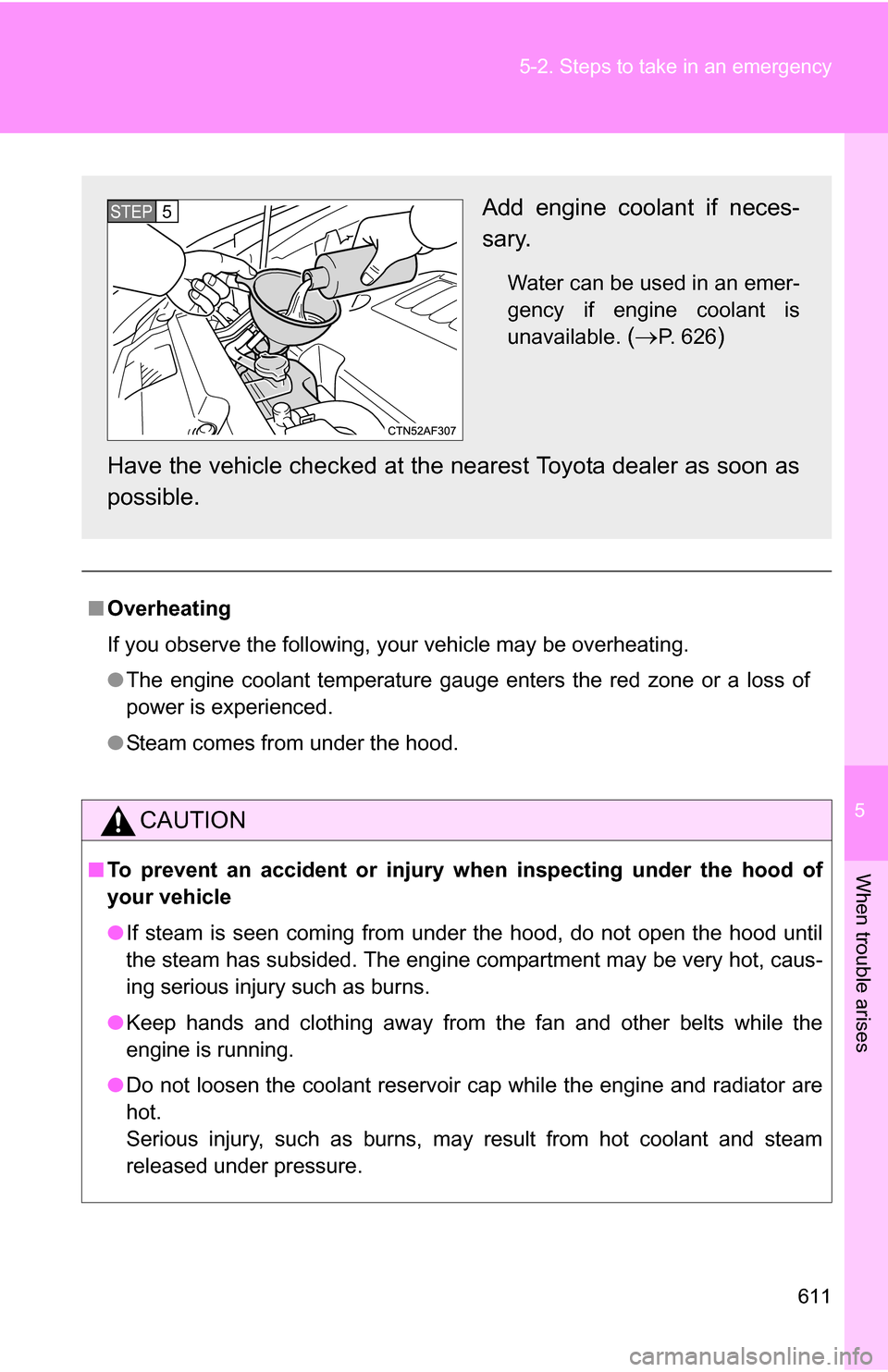
5
When trouble arises
611
5-2. Steps to take in an emergency
■
Overheating
If you observe the following, your vehicle may be overheating.
●The engine coolant temperature gauge enters the red zone or a loss of
power is experienced.
● Steam comes from under the hood.
CAUTION
■To prevent an accident or injury when inspecting under the hood of
your vehicle
●If steam is seen coming from under the hood, do not open the hood until
the steam has subsided. The engine compartment may be very hot, caus-
ing serious injury such as burns.
● Keep hands and clothing away from the fan and other belts while the
engine is running.
● Do not loosen the coolant reservoir cap while the engine and radiator are
hot.
Serious injury, such as burns, may result from hot coolant and steam
released under pressure.
Add engine coolant if neces-
sary.
Water can be used in an emer-
gency if engine coolant is
unavailable.
(P. 626)
Have the vehicle chec ked at the nearest Toyota dealer as soon as
possible.
STEP5
Page 672 of 684
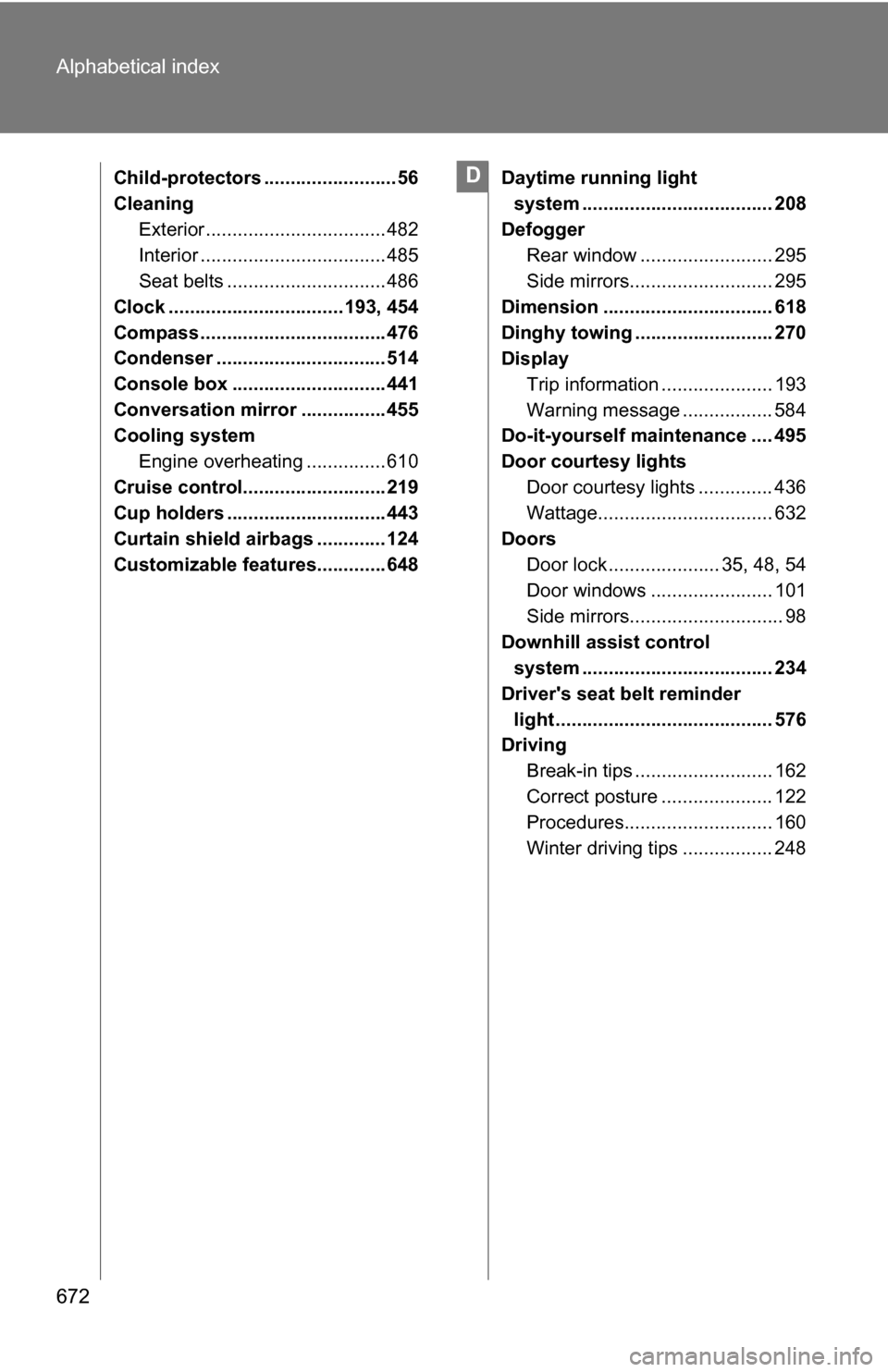
672 Alphabetical index
Child-protectors .........................56
CleaningExterior .................................. 482
Interior ................................... 485
Seat belts .............................. 486
Clock ................................. 193, 454
Compass ................................... 476
Condenser ................................ 514
Console box ............................. 441
Conversation mirror ................455
Cooling system Engine overheating ............... 610
Cruise control........................... 219
Cup holders .............................. 443
Curtain shield airbags ............. 124
Customizable features............. 648 Daytime running light
system .................................... 208
Defogger Rear window ......................... 295
Side mirrors........................... 295
Dimension ................................ 618
Dinghy towing .......................... 270
Display Trip information ..................... 193
Warning message ................. 584
Do-it-yourself maintenance .... 495
Door courtesy lights
Door courtesy lights .............. 436
Wattage................................. 632
Doors Door lock ..................... 35, 48, 54
Door windows ....................... 101
Side mirrors............................. 98
Downhill assist control system .................................... 234
Driver's seat belt reminder light ......................................... 576
Driving
Break-in tips .......................... 162
Correct posture ..................... 122
Procedures............................ 160
Winter driving tips ................. 248D
Page 673 of 684
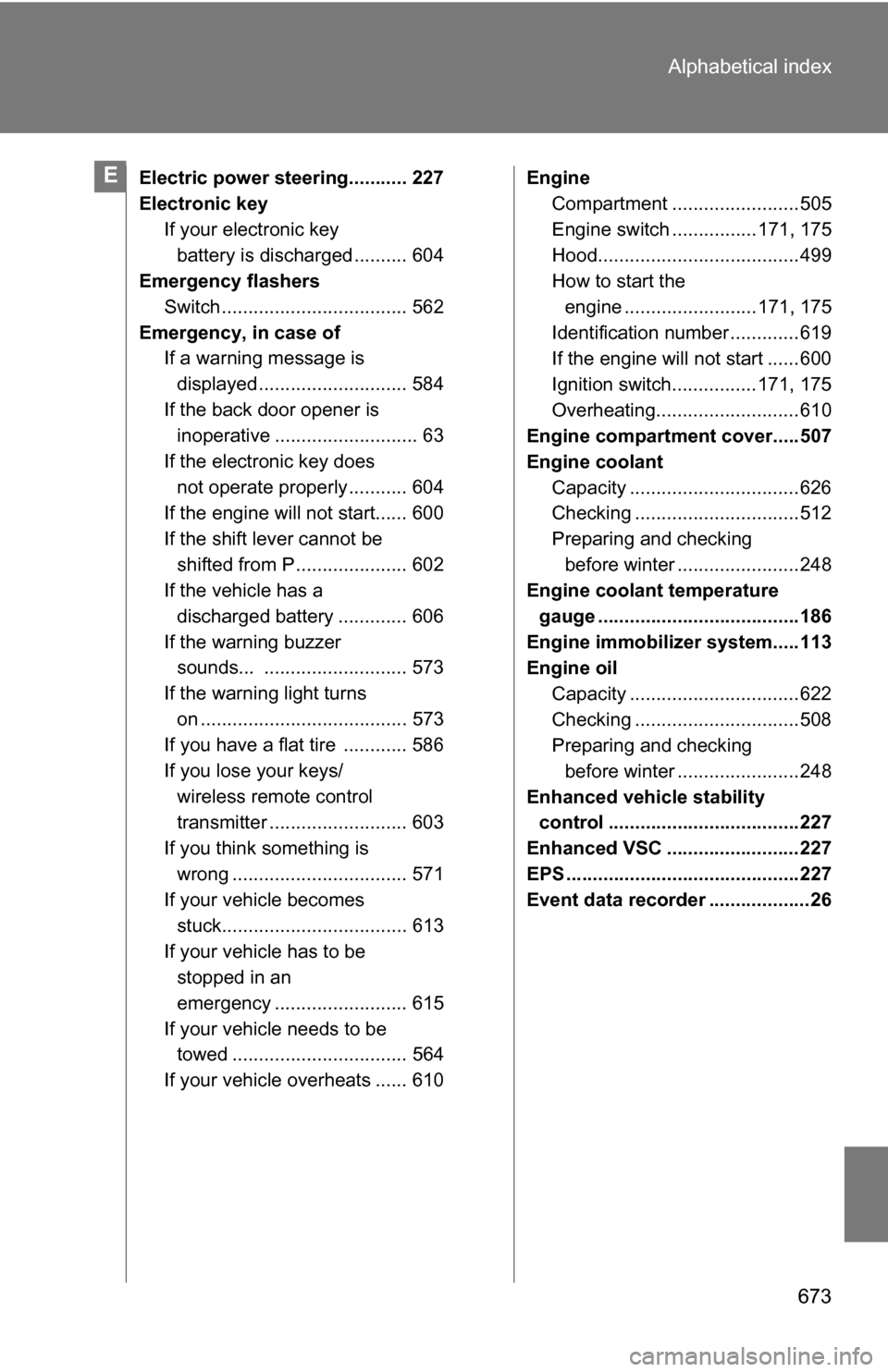
673
Alphabetical index
Electric power steering........... 227
Electronic key
If your electronic key battery is discharged .......... 604
Emergency flashers
Switch ................................... 562
Emergency, in case of If a warning message is
displayed ............................ 584
If the back door opener is inoperative ........................... 63
If the electronic key does not operate properly ........... 604
If the engine will not start...... 600
If the shift lever cannot be
shifted from P ..................... 602
If the vehicle has a
discharged battery ............. 606
If the warning buzzer sounds... ........................... 573
If the warning light turns on ....................................... 573
If you have a flat tire ............ 586
If you lose your keys/
wireless remote control
transmitter .......................... 603
If you think something is wrong ................................. 571
If your vehicle becomes
stuck................................... 613
If your vehicle has to be stopped in an
emergency ......................... 615
If your vehicle needs to be towed ................................. 564
If your vehicle overheats ...... 610 Engine
Compartment ........................505
Engine switch ................171, 175
Hood......................................499
How to start the
engine .........................171, 175
Identification number .............619
If the engine will not start ......600
Ignition switch................171, 175
Overheating...........................610
Engine compartment cover.....507
Engine coolant
Capacity ................................626
Checking ...............................512
Preparing and checking before winter .......................248
Engine coolan t temperature
gauge ......................................186
Engine immobilizer system.....113
Engine oil Capacity ................................622
Checking ...............................508
Preparing and checking before winter .......................248
Enhanced vehicle stability control ....................................227
Enhanced VSC .........................227
EPS ............................................227
Event data recorder ...................26E
Page 676 of 684
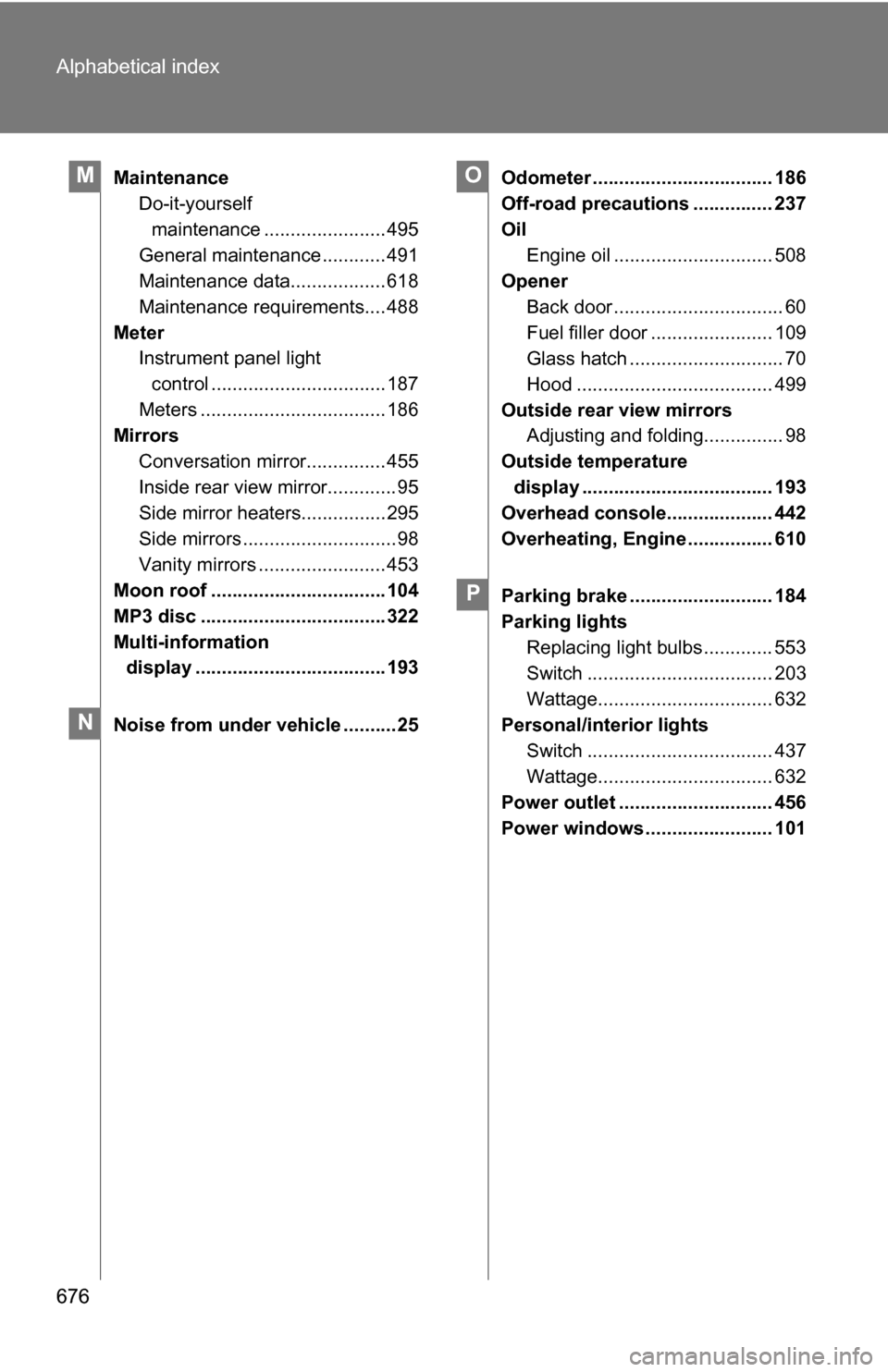
676 Alphabetical index
MaintenanceDo-it-yourself
maintenance ....................... 495
General maintenance ............ 491
Maintenance data.................. 618
Maintenance requirements.... 488
Meter Instrument panel light
control ................................. 187
Meters ................................... 186
Mirrors
Conversation mirror............... 455
Inside rear view mirror.............95
Side mirror heaters................295
Side mirrors .............................98
Vanity mirrors ........................ 453
Moon roof ................................. 104
MP3 disc ................................... 322
Multi-information display .................................... 193
Noise from under vehicle ..........25 Odometer .................................. 186
Off-road precautions ............... 237
Oil
Engine oil .............................. 508
Opener
Back door ................................ 60
Fuel filler door ....................... 109
Glass hatch ............................. 70
Hood ..................................... 499
Outside rear view mirrors Adjusting and folding............... 98
Outside temperature display .................................... 193
Overhead console.................... 442
Overheating, Engine ................ 610
Parking brake ........................... 184
Parking lights Replacing light bulbs ............. 553
Switch ................................... 203
Wattage................................. 632
Personal/interior lights
Switch ................................... 437
Wattage................................. 632
Power outlet ............................. 456
Power windows ........................ 101M
N
O
P